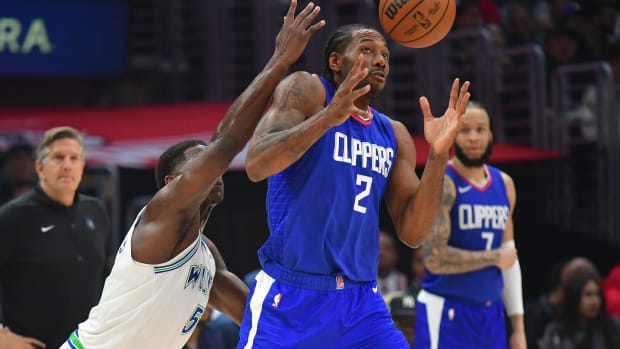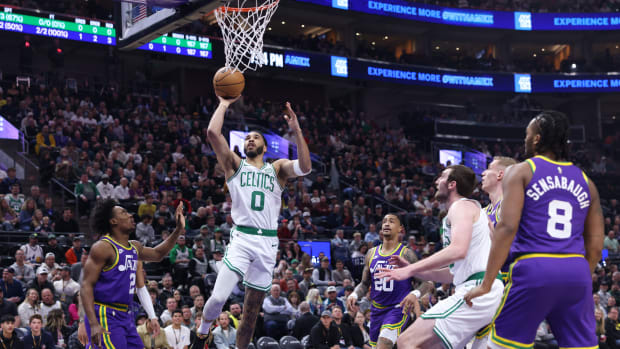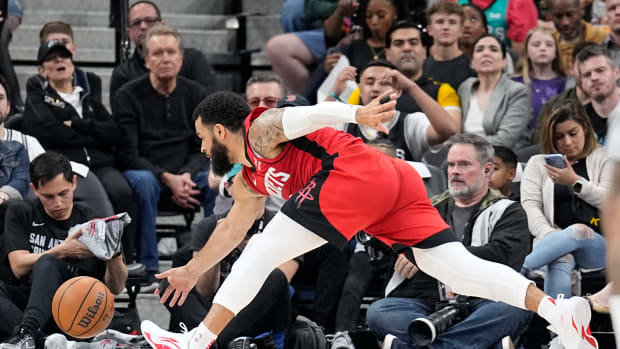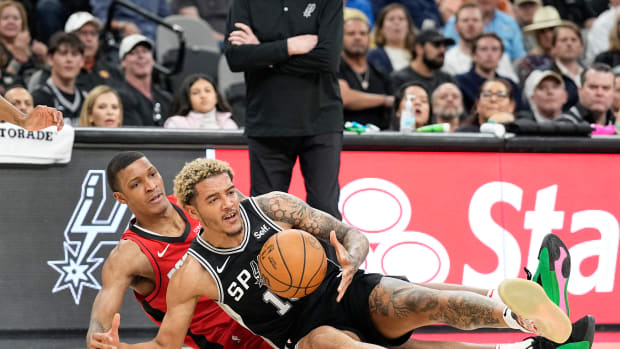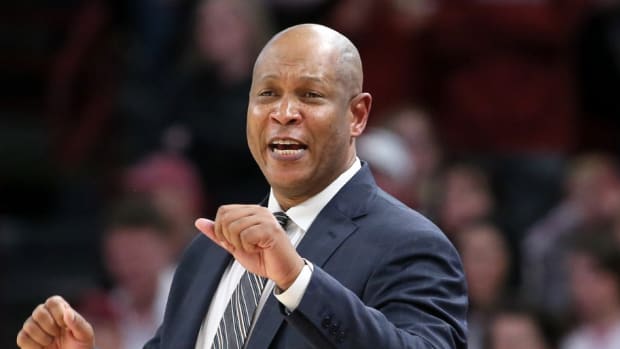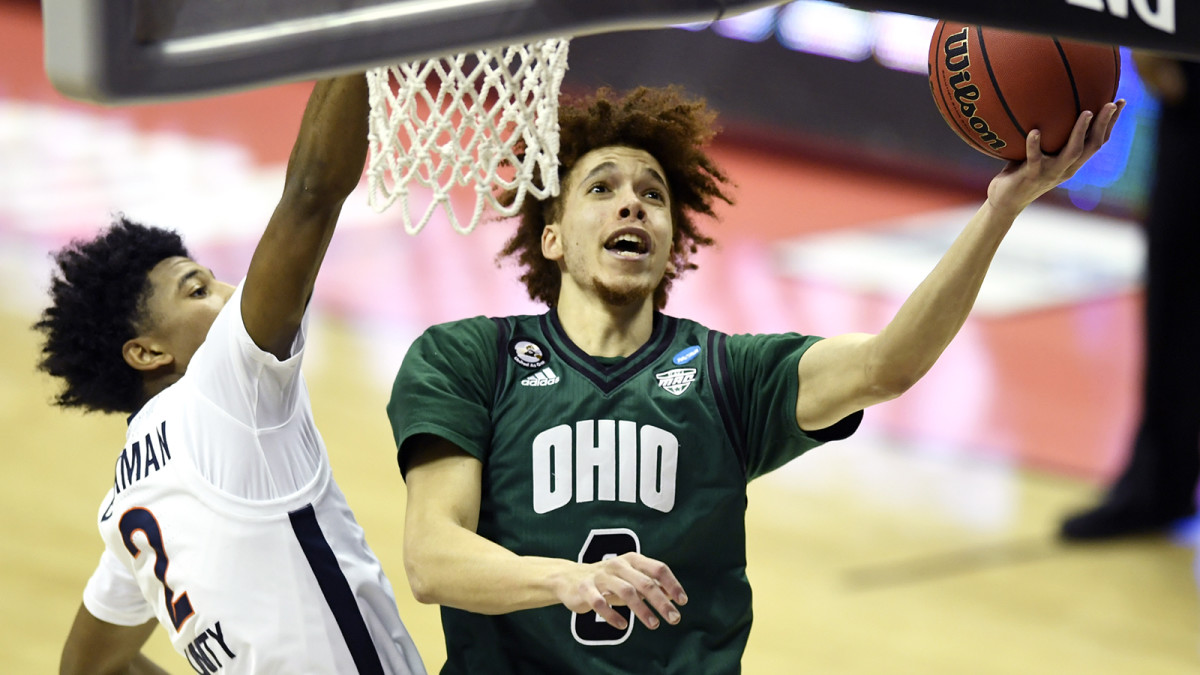
The Biggest NBA Draft Sleepers
With the G League Elite Camp and NBA combine on tap for next week, the predraft process is about to get real, offering players a significant platform to visit with teams and showcase their skills. Much will inevitably change over the next six weeks, and we’ll have updates to the mock draft and Big Board, and much more draft coverage forthcoming.
For now, let’s take a moment to dig deeper into the player pool. After months of digging through stats and game film and gathering information, I’ve identified five underappreciated prospects to watch for as the draft approaches. They are as follows.
Jason Preston, PG, Ohio | Junior
Height: 6' 4" | Weight: 185 | Age: 21
Preston was one of the breakout stars of college basketball season, building a name for himself in leading Ohio to the NCAA tournament and an upset win over Virginia. The NBA took note well before that, with his 31-point, eight-assist, no-turnover showing against Illinois in November placing him squarely on the radar as a prospect. And while the buzz surrounding him has been minimal for much of the season, Preston has piqued legit interest from front offices, earning an invitation to the combine with a real opportunity to work his way toward a top-40 selection. I watched Preston work out in private earlier this month and came away impressed. He checked in at No. 65 on my Big Board back in April, which admittedly was much too low.
The tape should work in his favor, as it doesn’t take much to see Preston is one of the best pure passers in the draft. Assist rates of 37.6% and 39.8% while logging heavy minutes each of the last two seasons speak to the quality of his work as Ohio’s primary offensive engine. He’s an imaginative, improvisational playmaker who’s comfortable passing on the move, has terrific vision from a range of spots on the floor, and poses consistent danger when manipulating screens. At 6' 4" with a plus wingspan, Preston’s size will play up, and he should be able to add some muscle to his slender frame. He’s also a bit more athletic than he gets credit for, employing pace and change of speeds to compensate for what he gives up in terms of strength and explosiveness. Preston is universally praised for his basketball IQ, and his unselfish approach will endear him to teammates. There are obvious elements here that could lead to success as a pass-first bench playmaker, in the vein of NBA guards like Monte Morris.
The primary questions surrounding Preston at the moment are the quality of his jumper, his ability to separate on offense and his individual defense. He was a consistent three point shooter the last two seasons, shooting 38.5% and 39.8%, respectively, and while the volume wasn’t especially high, his mechanics are solid and his balance and footwork as a shooter stand out. It’s a bit odd that Preston made just 59.6% of free throws as a junior and got to the line far less frequently after shooting 72% the year before. But his shot looks workable up close, and sharpening the consistency of his release will go a long way. While he’s fairly strong-hand dominant around the basket, he’s a crafty finisher and converted 68.6% of attempts at the rim, according to Barttorvik.com. Preston spent most of the season facing defenses geared toward making his life difficult. There’s certainly enough here offensively to pique further curiosity.
Preston moves better north-south than laterally, and he’ll have to continue proving he can defend effectively enough to stay on the floor. This is where his size and length become even more meaningful, and where he might be able to add defensive value away from the point of attack. His smarts and anticipation should go a long way toward making him passable on that end, as will adding some strength in the weight room. All he needs to do is guard well enough to stay on the floor, and it’s a worthwhile bet, particularly relative to other guards projected to land in the middle of the draft.
The shape of this class could really work in Preston’s favor, as there’s a dearth of true point guards projected to be available in the 20–40 range. Not every team will have interest in drafting a teenager, and upon close examination, Preston’s skill set holds up well with other experienced college guards like Joel Ayayi, Ayo Dosunmu and David Johnson, all of whom are more naturally combo guards than lead playmakers. Still, due to his mid-major background and lesser degree of exposure against top competition, Preston has more to prove in the eyes of many scouts. He can force the issue with a good showing at the combine. His feel, competitiveness and resilience are well worth the bet.
RaiQuan Gray, F, Florida State | Junior
Height: 6' 8" | Weight: 260 | Age: 21
Gray has come up frequently in passing conversations with NBA personnel dating back to the NCAA tournament, and it presently seems like a good bet to hear his name called in the second round of the draft. Gray’s game is unorthodox and his heavy frame has inspired some skepticism from scouts, but he was effective in a do-everything role for Florida State this season, and he’s grown on me as an intriguing potential role player, with an unusual combination of frame, skills and feel that could create some versatility going up a level.
Listed at 6' 8”, 260, Gray has legitimate ballhandling skills and perimeter feel in the body of a small-ball center. He’s a fairly good athlete, and trimming just a little bit of weight might make him more mobile without sacrificing the heft he uses to his advantage as a driver and finisher. Although Gray struggles with turnovers on occasion, he has adequate vision as a passer and played a functional backup point guard role at times for the Seminoles. He can move his feet and make plays on the defensive end and guard all three frontcourt spots depending on personnel. Gray’s motor is typically consistent, and he hit his stride in conference play after a quiet December.
While there are some obvious questions—Gray can be slow getting downhill, made just eight of his 30 three-point attempts and was often mistake-prone—most of the intrigue stems from a line of thinking that suggests he might be where the NBA is headed. His ability to play and think effectively from a variety of spots on the floor is a clear plus. Some scouts have thrown around a diet Draymond Green comparison, which I personally think is a step too far. But his basketball IQ is fairly sound, and as a player who can fend for himself when the ball is swung to him, defend multiple positions, and provide a little bit of value on both ends, there’s a pathway for Gray to succeed.
Of course, Gray will need to shoot a lot better for that to work. But everyone in the second round has warts, and he’s one of this year’s more interesting “if-he-shoots” prospects, which is something teams grapple with every year. Consider that dropping some weight could unlock another level to his game and unlock some extra quickness and explosiveness, and there’s some interesting upside here. Pitted against other small-ball oriented, second-round forwards like Justin Champagnie and Herbert Jones, Gray’s offensive versatility is a separator. He’s an obvious two-way contract candidate and may wind up with more if the market for his services expands. Impressive combine measurements and on-court performance could lead to an accelerated spike in value over the next six weeks.
Jose Alvarado, PG, Georgia Tech | Senior
Height: 6' 0" | Weight: 180 | Age: 23
While undersized point guards can be an acquired taste for NBA teams, there are always players who outkick convention and carve out meaningful roles. Accomplishing that feat and finding an NBA niche typically requires unusual levels of toughness, reliability and work ethic. For recent examples, consider that Payton Pritchard and Malachi Flynn snuck into the first round in last year’s draft, or the season T.J. McConnell just put together off the Pacers’ bench. While Alvarado projects as a second-rounder at best, he has a real chance to make a roster and help a team in short order, and he looks like a potential bargain for a team willing to roll the dice.
Although he didn’t receive full credit—teammate Moses Wright won Conference Player of the Year honors—there’s a real case to be made that Alvarado was the best player in the ACC last season. It was the culmination of his run as a four-year starter, in which Georgia Tech improved each year. It was also his best individual season, underscored by career-best shooting splits (58.6% on twos, 39% on threes and 83.8% from the line), 4.1 assists per game and a ridiculous 4.5% steal rate. The Yellow Jackets overachieved and won the conference tournament, and Alvarado won Defensive Player of the Year.
As is the case with many guards in his mold, the question isn’t whether Alvarado is good, but what elements of his skill set will translate against NBA competition. It’s hard to play in the league at his size. Alvarado is a good finisher (68.2% at the rim, per Barttorvik) and a smart playmaker who takes terrific care of the ball, but his individual offense will be put to the test immediately. His ability to make jumpers will become more central to his role, and he’s a good but not elite shooter. He’ll primarily be tasked with running bench units, using screens, and complementing whoever is on the floor around him. Facundo Campazzo was one of the best guards in Europe for years before joining the Nuggets, but the idea here is somewhat similar. Alvarado needs to figure out how to be adequate, with more of his value coming in an intangible sense, and his uptick in efficiency as a senior bodes well to that end.
Defensively, Alvarado was a special college player, and I’d argue that there’s a better chance his skills will carry over in a meaningful way than the vast majority of guards in his mold. It would be a stretch to think he’ll contain the NBA’s best ballhandlers, but there’s zero doubt that his effort level and competitive fight will be there on a nightly basis. Alvarado is gifted with exceptionally strong and quick hands, and high-level anticipation skills. His ability to win 50-50 balls and blow up plays in his general vicinity is highly unusual, particularly for a smaller guard. There’s no level of fear or hesitation. His steal rate is likely to trend down in the pros, but the intrinsic value of having a tone-setting player like Alvarado on the floor will mean something. It’s easy to see a team falling in love with that idea. The upside proposition here, of course, is limited: At best, Alvarado will become a backup who can hold his own and lead bench units. But thanks to his makeup and intangibles, he has a chance to be a unique, valuable version of that player, and come at a relative discount for an interested team.
Dalano Banton, G/F, Nebraska | Sophomore
Height: 6' 9" | Weight: 205 | Age: 21
A native of Toronto, Banton has spent much of his career flying under the radar, and he enters the draft as a fascinating deep cut, albeit a long shot to be drafted. The point forward was a top-100 recruit, but landed at Western Kentucky as a freshman in 2018–19, sitting out the following season while transferring to Nebraska, and posting pedestrian counting stats (9.6 points, 5.9 rebounds, 3.9 assists) on a team that went 7–20. He snuck into this year’s draft, declaring just before the early-entry deadline with little fanfare. At surface level, last season’s shooting splits don’t pop at all shooting 49.6% on twos, 24.1% on 79 three-point attempts and 66% from the foul line. On the brighter side, he led Nebraska in assist rate (27.5%) and shot 60.3% around the rim, per Barttorvik.com data.
For better or worse, much of the intrigue with Banton centers around the oft-maligned eye test. But if you’re an NBA team willing to take a flier on a player who can’t really shoot, investing in a huge, skilled passer is a pretty interesting thing to consider. Banton’s broad shoulders and long arms pop immediately on film, and his height gives him legitimate functionality using ball screens, able to see over defenders and giving him access to passing angles that smaller handlers don’t have. He delivers the ball well using a variety of passes, and his size allows him to rebound, push in transition and help facilitate early offense. Banton has a long stride that helps him cover ground quickly, and, while not particularly explosive, he has a workable degree of pace as a handler and gets good extension in the paint on finishes. His overall feel for moving the ball stands out immediately, even as bad as Nebraska was this season. The playmaking seems bankable as an NBA-level skill.
Banton’s frame should also make him playable as a team defender—he’s listed at 6' 9" and looks to be legitimately in that ballpark on film. His length allows him to effectively disrupt passing lanes, contest out onto shooters and have a visual impact on opposing guards. Banton is a bit slow-footed laterally, and his effort on the defensive end also leaves something to be desired, as he tends to be slow to contain on the perimeter and occasionally lazy fighting through screens. He’s more effective defending away from the ball, to be sure. But a better level of effort could make him at least marginally valuable on that end of the floor in relatively short order. He’s functionally big enough to defend wings and forwards. The care factor is something he can control.
The biggest issue here is the jumper, which is the source of Banton’s offensive inefficiencies and will require a good amount of work to become respectable. A quick dive into his film reveals some inconsistency in his shot base (foot placement in particular) as well as his wrist—which led to some wild misses, but also some excusable ones given his team context and the fact that he was tasked with creating late in the shot clock. I’m not a shooting coach, nor will I pretend to be, but Banton’s shot doesn’t look broken. However, it’s clearly something he’ll have to spend a lot of time on just to reach respectability, which would make a big difference in his outlook. He relocates well off the ball and knows where to find the shots, but Banton will have to start making them to be a truly functional role player and more than a curiosity. But bottom line, there aren’t many players with his type of skill set just lying around. There’s legitimate role player potential here, and there should be interest in his services in the likely event he goes undrafted.
EJ Onu, F/C, Shawnee State (NAIA) | Senior
Height: 6' 11" | Weight: 240 | Age: 21
While Onu’s path to the pros has been unorthodox, the pathway for him to sticking in the league is pretty simple. He has legit size for a center, shot 40% from three on 130 attempts as a senior and averaged 16.9 points, eight rebounds and 4.5 blocks in 33 games. Granted, this was playing at the NAIA level, where he was an All-America at Shawnee State in Ohio and led his team to a national championship last season. He’s due for a major uptick in competition this fall, whether he opts to return to college as a grad transfer or make the leap to the pros. But on tape, there’s a clear level of intrigue with Onu, thanks to a translatable skill set and his late-blooming development curve. It was enough to earn him an invite to G League Elite Camp, where he’ll have a big platform to prove he belongs.
During a workout at a team’s facility this month, Onu measured at 6' 10" barefoot with a massive 7' 8" wingspan, metrics that will play up at any level of basketball. Despite a massive high-school growth spurt, he remained under the radar, and he chose to stay put when some Division I programs came calling the past few years. And he totaled a whopping 529 career blocks in four seasons. The game is going to speed up for him, and it’s unlikely he’ll be quite that prolific in the long run, but there’s a history of rim-protecting prowess here, and an undeniable degree of instincts and above-average mobility around the rim. Onu isn’t particularly quick off the floor, but he moves his feet, covers ground and positions his body well, and the film suggests some legitimate upside as a drop-coverage big who can wall off space. It’s easy to understand why his numbers are that prolific, relative to his level.
While Onu will have a lot of learning to do to score efficiently in the paint and make himself dangerous against NBA defenses, if he can simply be a successful floor spacer and pick-and-pop screener, it should expedite his path to a potential role and open up roster opportunities. His shooting looks legitimate on tape, and he shoots with a level of confidence and solid mechanics (and a release point that’s tough to contest). His numbers are impressive for a prospect of any size at any level. There are plenty of stretch bigs in the world, but there aren’t many with Onu’s measurables, and few who can impactfully defend the basket at the highest level. Of course, it’s possible—perhaps likely—that Onu will struggle with his adjustment in the short term. We don’t know for certain whether he can do those things yet. But his statistical sample suggests there’s something there as a baseline.
In all likelihood, this will be a longer-tail development process. Onu is staring down a major adjustment to the speed, explosion and unforgiving nature of NBA competition. But if a team can afford to be patient, Onu’s skill profile points to the type of big who can hold his own coming off the bench for a playoff team, able to space the floor to a capable extent while providing resistance defensively against taller fives. For NBA teams, the drawback with these types of projects is that by the time a player is ready to contribute, you risk losing them on their next contract. Plus, Onu turns 22 this summer. If he stays in the draft, Onu will spend much of next season in the G League, regardless. Considering the dearth of stretch fives expected to be available on the undrafted market, he’s an interesting investment.
More NBA Playoffs Coverage:
• Suns Sweep Nuggets Behind CP3's Big Night
• Durant and the Nets Falter Without Harden and Irving
• The Clippers Are Battling the Jazz—and Their Own Cursed History































